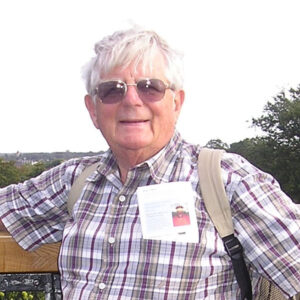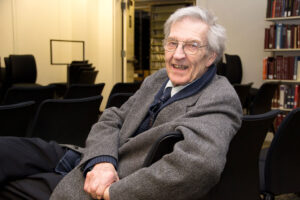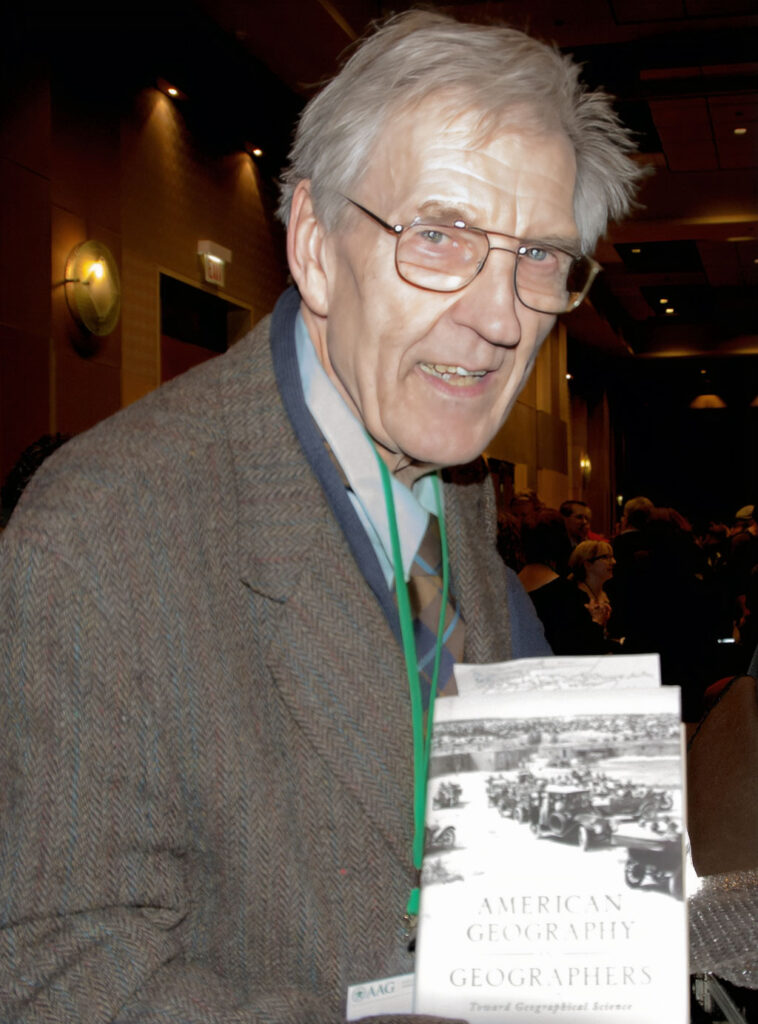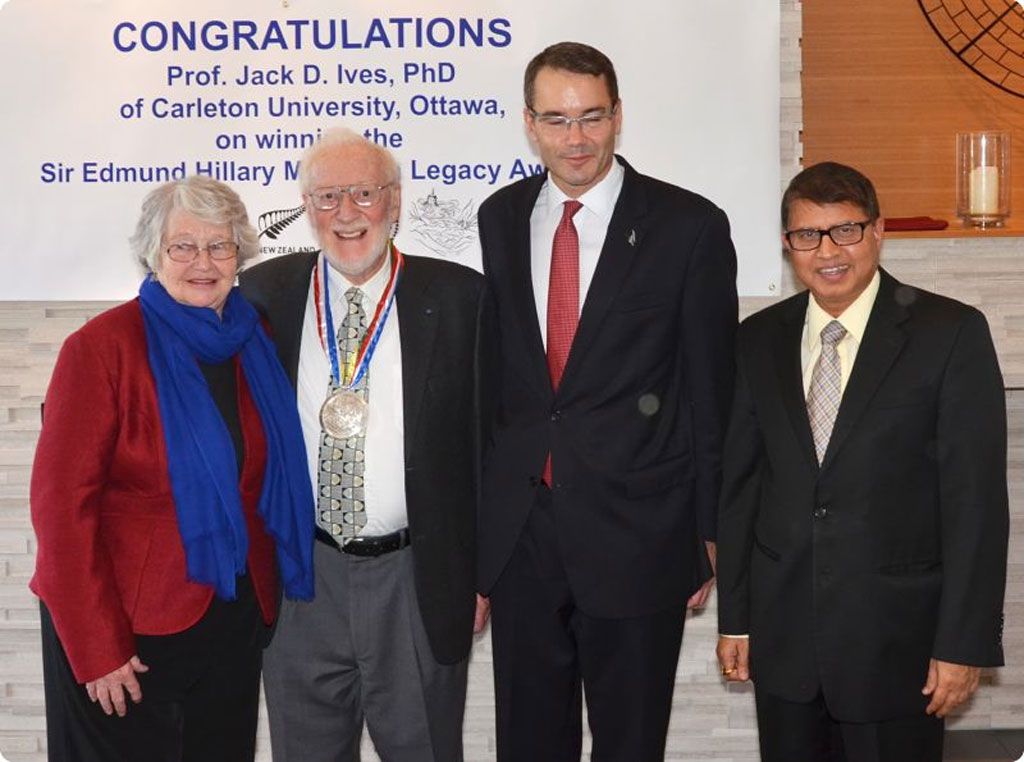Julian Vincent Minghi passed away peacefully on July 26, 2024. A longtime professor of geography at the University of South Carolina Columbia, he had a lasting impact on the careers of his peers and succeeding generations of geographers.
Born in 1933 in London, Dr. Minghi spent his early years in Sussex and Wales. In his youth he traveled to Italy’s Piedmont and Tuscany regions, returning during his undergraduate years to climb the Italian Alps with famous mountain climber Walter Bonatti. These experiences influenced him to become a professional geographer with strong interests in boundaries and borderlands. He was also stimulated by his undergraduate professor, John House, from the University of Durham, who was held in high regard by his peers for pioneering works in political geography.
He received his M.A. and Ph.D. degrees from the University of Washington, where he was advised by Douglas Jackson who was known for cutting-edge approaches to studying interstate political worlds. Minghi’s 1961 Ph.D. dissertation addressed what then were innovative themes and approaches, for example, the impacts of cross-border landscapes in the emerging worlds of television. During this time, he met his wife and life companion Lee.
Active in the American Association of Geographers as a Council member, he also served on the International Geographical Union’s Commission on World Political Geography, where he worked in early years with John House, Ron Johnston, Bertha Becker, David Knight, John O’Loughlin, Anton Gosar, Werner Gallusser, Saul Cohen, Dennis Rumley, Vladimir Kolossov, Andre Louis Sanguin, Peter Taylor and others advancing political geography on many fronts.
Julian Minghi changed political geography through such work as his article “Boundary Studies in Political Geography,” published in the Annals of the American Association of Geographers in 1963, signaling a new turn in the study of boundaries and borders. He co-edited, with Roger Kasperson, the comprehensive book The Structure of Political Geography. First published in 1969 and still in print, it changed political geography and the two mens’ careers.
“In the huge upheavals of geography in the 1960s, political geography was nowhere to be seen,” recalled Peter Taylor, emeritus professor of geography at Loughborough University. “This changed with the publication of The Structure …. It converted political geography into a social science; 40 chapters organized into five sections: Heritage, Structure, Process, Behavior, and Environment — Wow! It certainly recruited me.”
“Julian Minghi stood out in international encounters of political geographers for his kind mentoring and his fascination with borders and borderlands,” said Virginie Mamadouh, associate professor of political and cultural geography at the University of Amsterdam.
“Minghi’s contributions to the field of political geography are immense,” said Reece Jones, chair of Geography and Environment at the University of Hawai‘i-Mānoa. “Thankfully, his legacy will continue to be recognized through the Julian Minghi Distinguished Book Award, which is given annually to the author of the best book in political geography by the Political Geography Specialty Group of the AAG.”
“There was little of note published in political geography in the 1950s before Julian’s first papers and especially his co-edited book with Kasperson, said John O’Loughlin, professor of political geography at the University of Colorado Boulder. “The book’s ambition and broad range of subjects showed the young scholars of the day what should be important research topics and had been neglected for too long.”
“Julian was a pioneer in the field of political geography [whose] major publications led many young geographers to take up political geography and study borders (at a time when it was still partially blackballed within academic and scientific circles due to erroneous associations with the Geopolitics of the Third Reich) and make it into the thriving discipline which it is today.” David Newman, professor of geography at Ben-Gurion University of the Negev.
Herman van der Wusten, professor emeritus of political geography at the University of Amsterdam, agrees: “Julian Minghi helped kickstart a new political geography in the 1970s. Later on he was fruitfully active on political boundary problems for humans and their landscapes as they were put up, withdrawn or got a different function. He was a great colleague who will be sorely missed.”
“In his long and distinguished career, Professor Minghi played a key role and link between an earlier generation of work on border studies in political geography and the revitalization of that field over the last thirty years,” said James Sidaway, professor of political geography at the University of Singapore. “This critical legacy will long endure,”
 Colleagues have praised Minghi’s energy and joyful spirit. He was “audacious and undisciplined … and a little bit playful,” in the words of Phil Steinberg, professor of political geography and arctic studies geographer at Durham University. Richard Schofield, senior lecturer in boundary studies at King’s College London, described Minghi as “a lovely man who continued to captivate my M.A. students at KCL on Geopolitics, Resources, and Territory into his 90s, delivering a usual annual clutch of lectures with relish and good humor. No one would ever call Julian a cowboy, but he did sort of die with his spurs on!”
Colleagues have praised Minghi’s energy and joyful spirit. He was “audacious and undisciplined … and a little bit playful,” in the words of Phil Steinberg, professor of political geography and arctic studies geographer at Durham University. Richard Schofield, senior lecturer in boundary studies at King’s College London, described Minghi as “a lovely man who continued to captivate my M.A. students at KCL on Geopolitics, Resources, and Territory into his 90s, delivering a usual annual clutch of lectures with relish and good humor. No one would ever call Julian a cowboy, but he did sort of die with his spurs on!”
Alexander (Alec) Murphy: professor emeritus of geography at University of Oregon, said, “Julian was an exceptionally warm, good humored, thoughtful political geographer who made pioneering contributions to the subdiscipline. His work with Roger Kasperson, The Structure …, helped to turn me toward political geography as a graduate student, and I cherished the many times we met at academic gatherings around the world. One of the great honors of my career was the invitation to give the first inaugural Julian Minghi Lecture at the University of South Carolina in 2007.”
Minghi’s knowledge of the world was always informed by his fascination with boundaries. “As a political geographer, Julian Minghi was professionally loyal to the Alps-Adriatic region,” recalled Anton Gosar, professor of geography at the University of Ljubljana. “He wrote extensively with Milan Bufon and made several field trips to the Italo-Slovenian border and organized conferences with scholars from both countries. Julian and his wife were fascinated by the mountain and Lakeland of the Julian Alps. They spent their honeymoon there and wanted to celebrate their anniversaries every year in the same facility.”
Mamadouh remembered, “One of the memorable moments was him sharing his memories of the evolution of the Italian/Slovenian border area over decades during the Cold War and after the disintegration of Yugoslavia when we were visiting Gorizia/Nova Goricia during a fieldtrip at the occasion of the Borderscapes III Conference in Trieste in summer 2012.”
Dennis Rumley, Professor of Indian Ocean Studies and Distinguished Research Fellow at Curtin University in Western Australia, called Minghi “an icon of political geography. He never got bored with borders. He was a very kind and generous man who had a wicked sense of humour. Like his favourite football team — Arsenal — Julian was always straight (talking in his case; shooting — for goal — their case). He clearly enjoyed life and had a positive and permanent impact on all who met and knew him. He will be missed by all of us.”
This memorial was prepared by Stanley Brunn, University of Kentucky, Lexington, insights and information from former colleagues and family members: Lee Minghi, Lynn Shirley, Anton Gosar, Reece Jones, David Knight, Victor Konrad, Virginie Mamadouh, Alec Murphy, David Newman, John O’Loughlin, Dennis Rumley, Richard Schofield, James Sidaway, Phil Steinberg, Peter Taylor and Herman van der Wusten.



 Colleagues have praised Minghi’s energy and joyful spirit. He was “audacious and undisciplined … and a little bit playful,” in the words of Phil Steinberg, professor of political geography and arctic studies geographer at Durham University. Richard Schofield, senior lecturer in boundary studies at King’s College London, described Minghi as “a lovely man who continued to captivate my M.A. students at KCL on Geopolitics, Resources, and Territory into his 90s, delivering a usual annual clutch of lectures with relish and good humor. No one would ever call Julian a cowboy, but he did sort of die with his spurs on!”
Colleagues have praised Minghi’s energy and joyful spirit. He was “audacious and undisciplined … and a little bit playful,” in the words of Phil Steinberg, professor of political geography and arctic studies geographer at Durham University. Richard Schofield, senior lecturer in boundary studies at King’s College London, described Minghi as “a lovely man who continued to captivate my M.A. students at KCL on Geopolitics, Resources, and Territory into his 90s, delivering a usual annual clutch of lectures with relish and good humor. No one would ever call Julian a cowboy, but he did sort of die with his spurs on!”